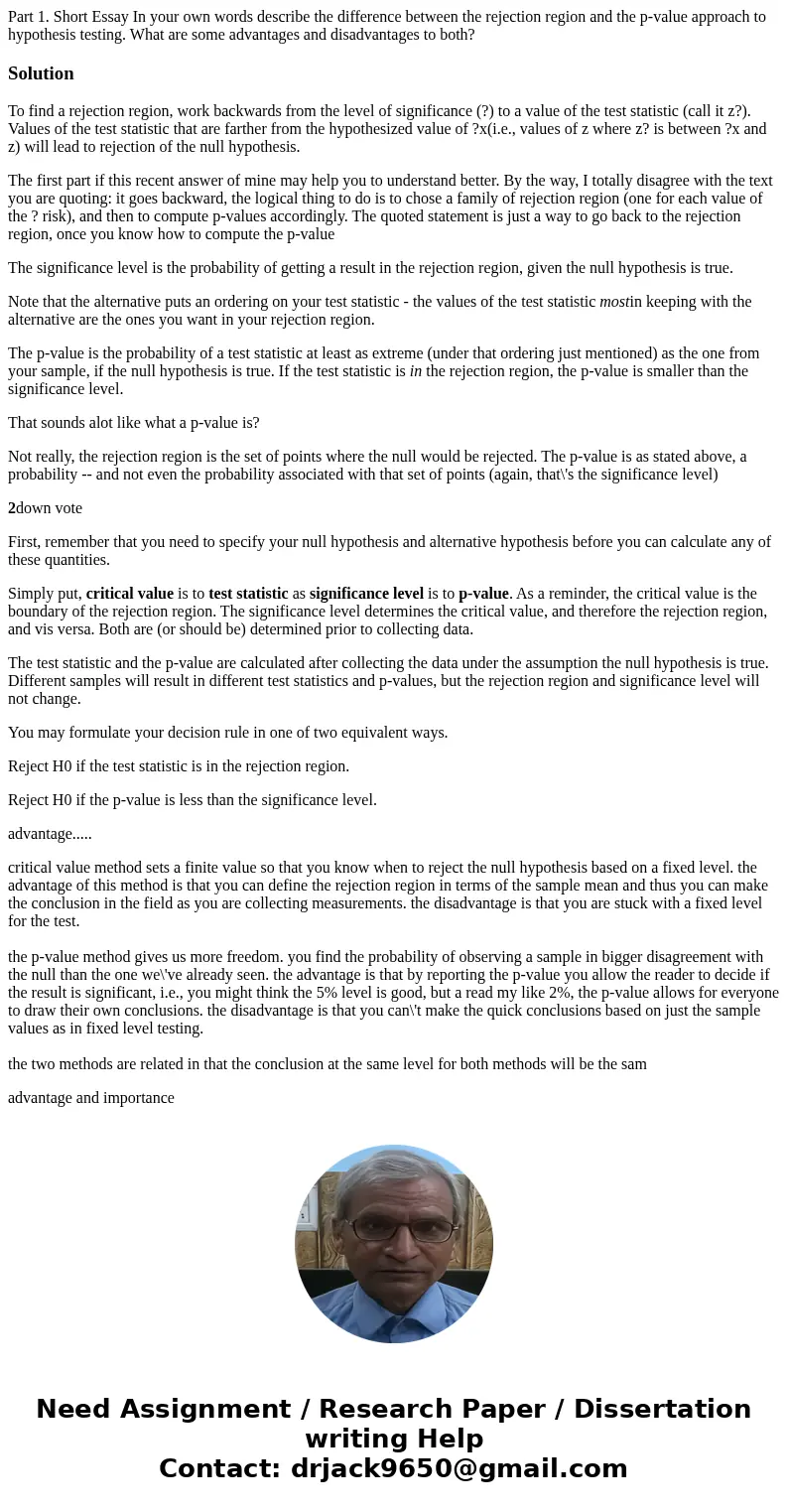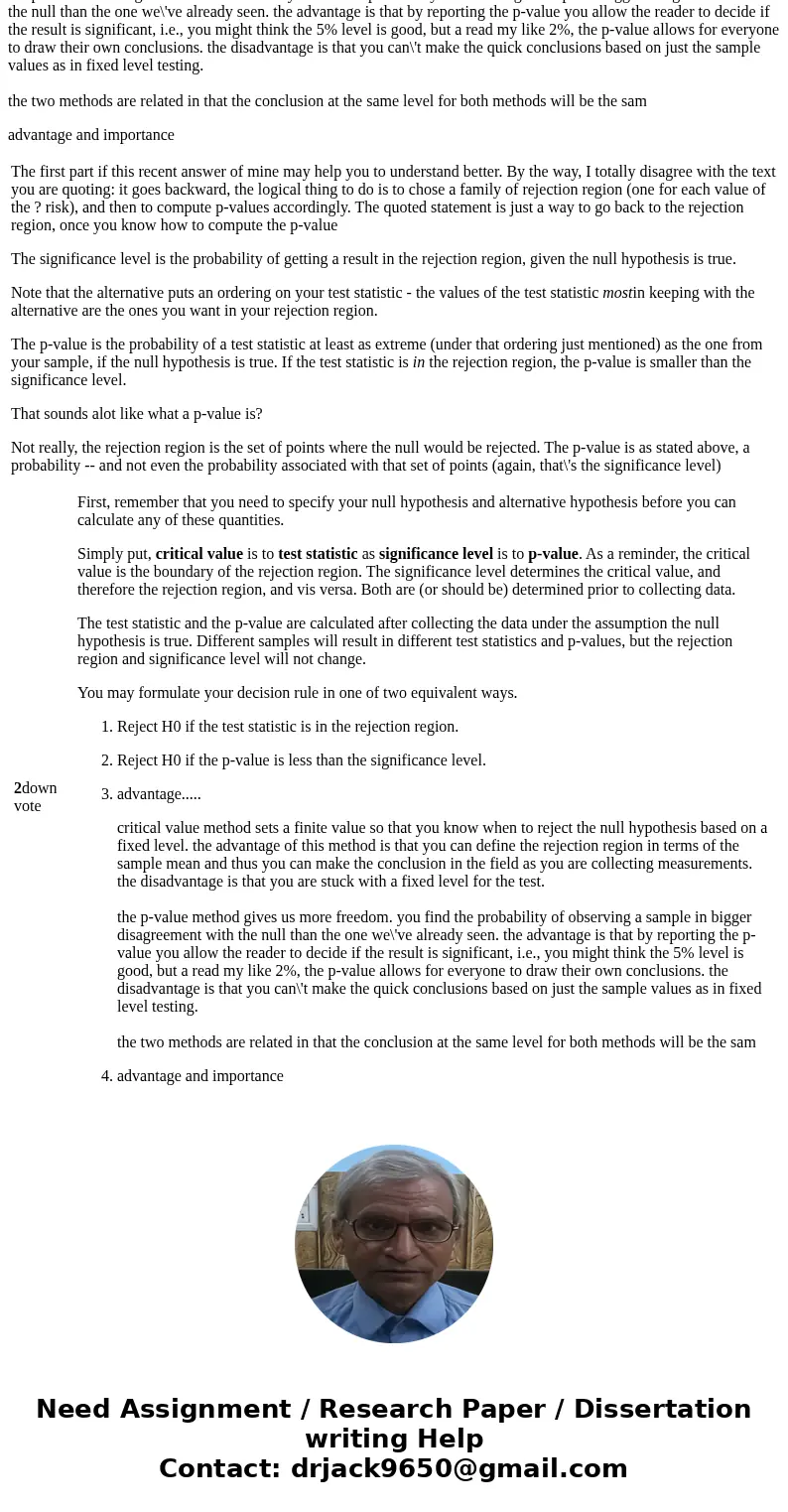Part 1 Short Essay In your own words describe the difference
Solution
To find a rejection region, work backwards from the level of significance (?) to a value of the test statistic (call it z?). Values of the test statistic that are farther from the hypothesized value of ?x(i.e., values of z where z? is between ?x and z) will lead to rejection of the null hypothesis.
The first part if this recent answer of mine may help you to understand better. By the way, I totally disagree with the text you are quoting: it goes backward, the logical thing to do is to chose a family of rejection region (one for each value of the ? risk), and then to compute p-values accordingly. The quoted statement is just a way to go back to the rejection region, once you know how to compute the p-value
The significance level is the probability of getting a result in the rejection region, given the null hypothesis is true.
Note that the alternative puts an ordering on your test statistic - the values of the test statistic mostin keeping with the alternative are the ones you want in your rejection region.
The p-value is the probability of a test statistic at least as extreme (under that ordering just mentioned) as the one from your sample, if the null hypothesis is true. If the test statistic is in the rejection region, the p-value is smaller than the significance level.
That sounds alot like what a p-value is?
Not really, the rejection region is the set of points where the null would be rejected. The p-value is as stated above, a probability -- and not even the probability associated with that set of points (again, that\'s the significance level)
2down vote
First, remember that you need to specify your null hypothesis and alternative hypothesis before you can calculate any of these quantities.
Simply put, critical value is to test statistic as significance level is to p-value. As a reminder, the critical value is the boundary of the rejection region. The significance level determines the critical value, and therefore the rejection region, and vis versa. Both are (or should be) determined prior to collecting data.
The test statistic and the p-value are calculated after collecting the data under the assumption the null hypothesis is true. Different samples will result in different test statistics and p-values, but the rejection region and significance level will not change.
You may formulate your decision rule in one of two equivalent ways.
Reject H0 if the test statistic is in the rejection region.
Reject H0 if the p-value is less than the significance level.
advantage.....
critical value method sets a finite value so that you know when to reject the null hypothesis based on a fixed level. the advantage of this method is that you can define the rejection region in terms of the sample mean and thus you can make the conclusion in the field as you are collecting measurements. the disadvantage is that you are stuck with a fixed level for the test.
the p-value method gives us more freedom. you find the probability of observing a sample in bigger disagreement with the null than the one we\'ve already seen. the advantage is that by reporting the p-value you allow the reader to decide if the result is significant, i.e., you might think the 5% level is good, but a read my like 2%, the p-value allows for everyone to draw their own conclusions. the disadvantage is that you can\'t make the quick conclusions based on just the sample values as in fixed level testing.
the two methods are related in that the conclusion at the same level for both methods will be the sam
advantage and importance
| The first part if this recent answer of mine may help you to understand better. By the way, I totally disagree with the text you are quoting: it goes backward, the logical thing to do is to chose a family of rejection region (one for each value of the ? risk), and then to compute p-values accordingly. The quoted statement is just a way to go back to the rejection region, once you know how to compute the p-value The significance level is the probability of getting a result in the rejection region, given the null hypothesis is true. Note that the alternative puts an ordering on your test statistic - the values of the test statistic mostin keeping with the alternative are the ones you want in your rejection region. The p-value is the probability of a test statistic at least as extreme (under that ordering just mentioned) as the one from your sample, if the null hypothesis is true. If the test statistic is in the rejection region, the p-value is smaller than the significance level. That sounds alot like what a p-value is? Not really, the rejection region is the set of points where the null would be rejected. The p-value is as stated above, a probability -- and not even the probability associated with that set of points (again, that\'s the significance level)
|


 Homework Sourse
Homework Sourse